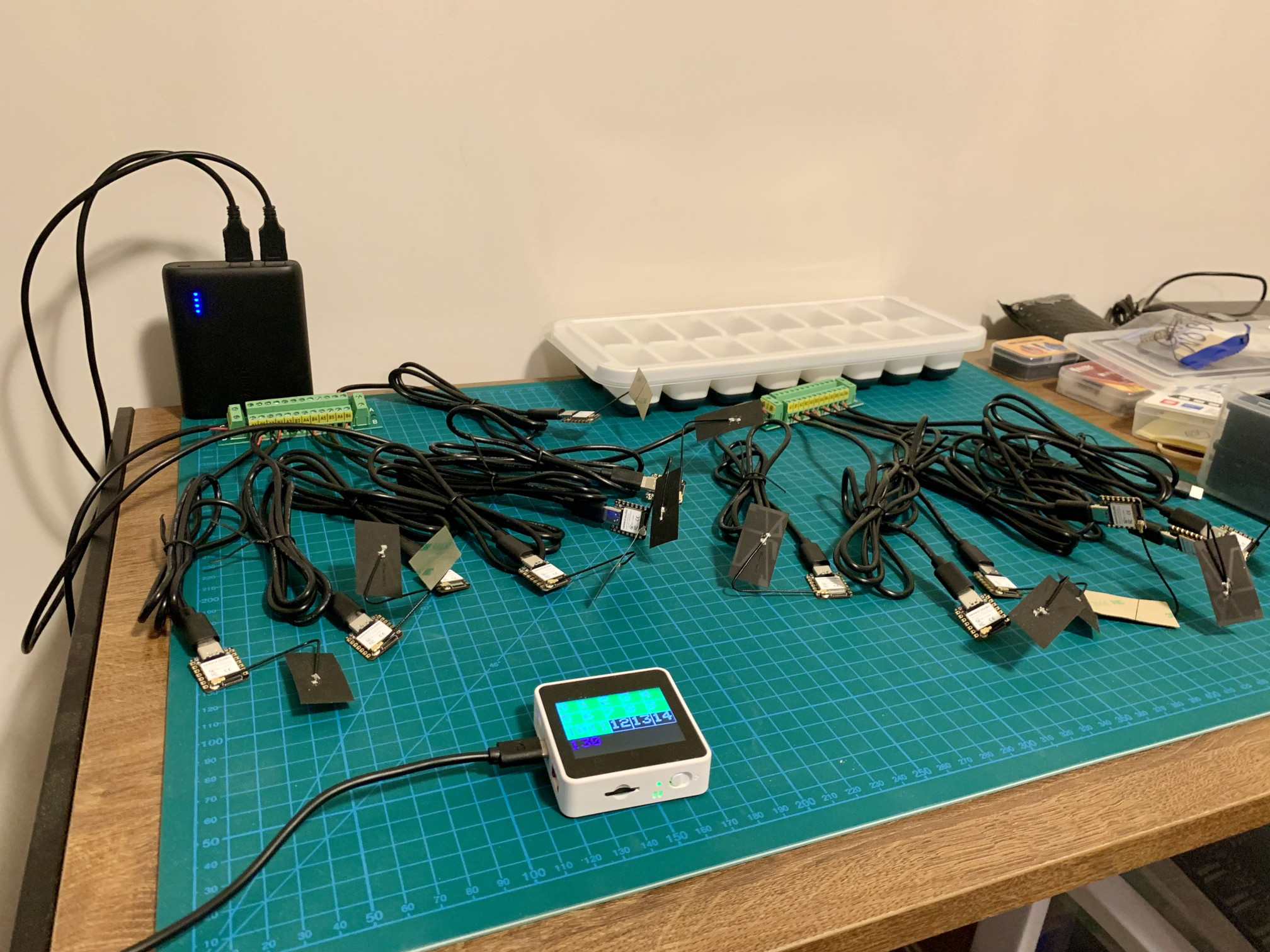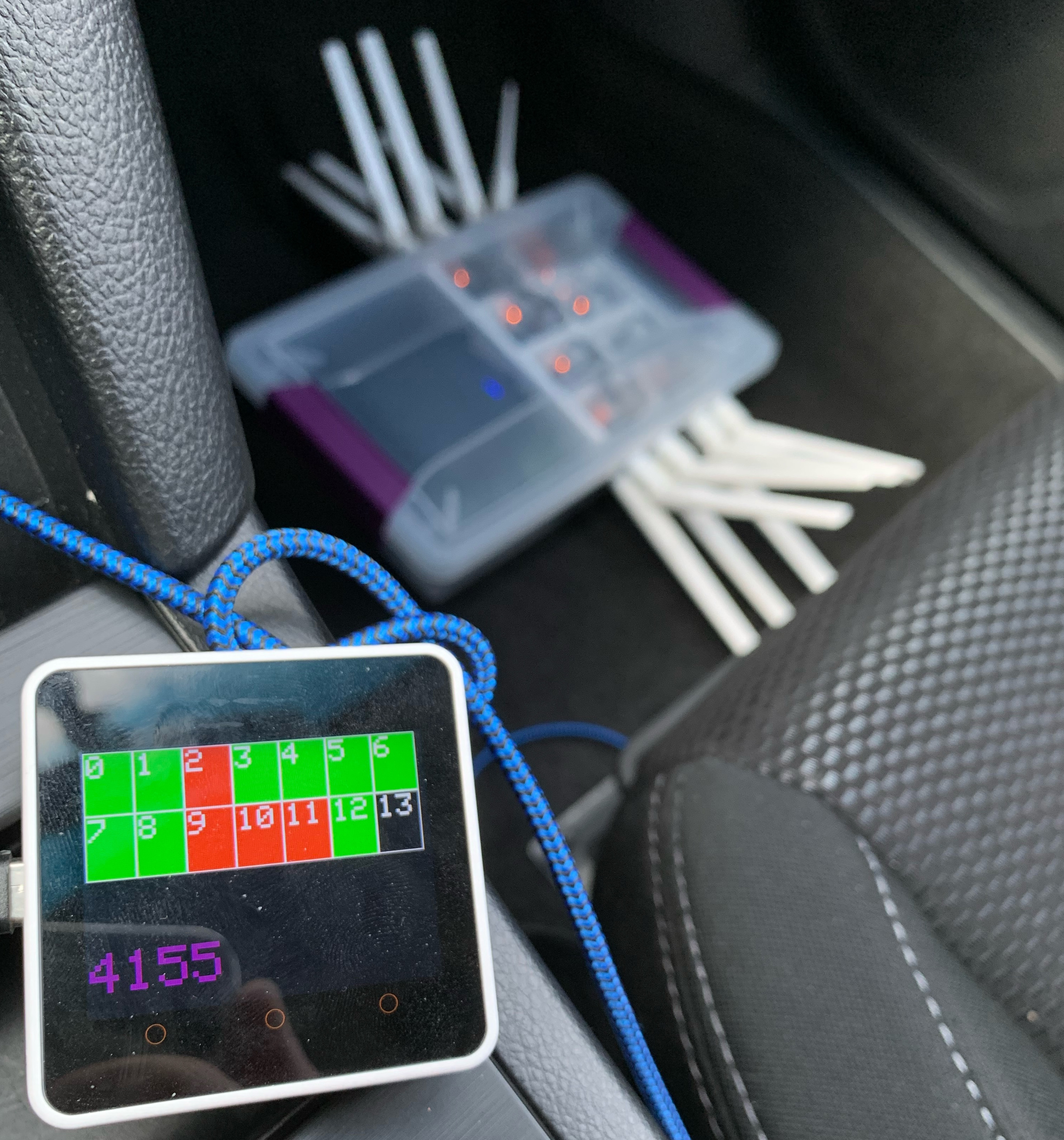This repo represents phase 1 of 3 of a larger overarching objective.
You can read about the nuance, design, and objectives here:
| Component | Link | Recommended Quantity |
|---|---|---|
| M5Stack Core2 ESP32 IoT Development Kit | https://shop.m5stack.com/products/m5stack-core2-esp32-iot-development-kit?variant=35960244109476 | 1 |
| Seeed Studio XIAO ESP32-S3 | https://www.seeedstudio.com/XIAO-ESP32S3-p-5627.html | 15 |
| 2.4GHz Rod Antenna for XIAO ESP32-S3 | https://www.seeedstudio.com/2-4GHz-2-81dBi-Antenna-for-XIAO-ESP32C3-p-5475.html | 14 |
| MicroSD Card w/ <= 16GB Capacity | https://www.amazon.com/Brand-SanDisk-Class-Micro-Memory/dp/B01FDBLC0C/ | 1 |
"Recommended Quantity" refers to the amounts of each item that should be purchased to directly replicate this project and scale as was carried out by the author. If only one of each component is purchased without any changes to hardware, the code will still compile, run, and demonstrate the project. It just will not be efficient.
rg-collector and rg-logger are PlatformIO projects targetting the XIAO ESP32-S3('s) and the M5Stack Core2 ESP32 respectively.
You must install PlatformIO before following the build steps:
I utilize several different libraries inthe codebase and set some build flags. PlatformIO projects are ✨magic✨ and will automatically download and configure everything as specificed.
rg-loader is a Golang module that handles reading and wrangling the data logged to the MicroSD card into a SQLite database for easy queries/transforms/exports/portability into formats you may wish to consume with other tooling. It is not intended to be a feature complete loader, but simply a way to get from point A to point B utilizing a language with strict error handling. You are encouraged to write your own loader, but be aware that you should expect a corrupted or malformed log item to occur at a rate of ~1/5000 for reasons that are completely out of scope of this project.
Hardware Target: Seeed Studio XIAO ESP32-S3
- Open
rg-collectorfolder in PlatformIO IDE, wait for libraries to install etc... - Connect
Seeed Studio XIAO ESP32-S3via USB - Open
platformio.ini - PlatformIO -> Project Tasks -> Upload
If you have completed the steps above, already have the PlatformIO IDE open, and wish to flash more than one collector:
- Connect
Seeed Studio XIAO ESP32-S3into USB - Open
src/main.cpp - Find
const int channel = 1; // WiFi Channel number between 1 and 13at the top of the file. - Increment the channel by 1
- PlatformIO -> Project Tasks -> Upload
This will spread out the WiFi channels as used for communication between devices and reduce interference. You will experience radio gremlins if you do not do this.
The device will restart and do absolutely nothing notable until a running rg-logger initializes it. This is by design.
Hardware Target: M5Stack Core2 ESP32
- Open
rg-loggerfolder in PlatformIO IDE, wait for libraries to install etc... - Connect
M5Stack Core2 ESP32via USB - Open
platformio.ini - PlatformIO -> Project Tasks -> Upload
The device will restart, attempt to initialize the MicroSD card, and begin attempting to discover and initialize rg-collector's.
The M5Stack LCD will display a grid 2x rows of 7 columns numbere 0-13 in the top half of the screen and a single number in the bottom half of the screen.
| 0 | 1 | 2 | 3 | 4 | 5 | 6 |
| 7 | 8 | 9 | 10 | 11 | 12 | 13 |
| 0 |
Each square of the top grid will begin black as uninitialized.
As rg-collector's are discovered the grid items will become green, indicating healthy.
As rg-collectors's healthcheck's pass their checkin expiration timeline (60s) they will become red, indicating they have exceeded healthcheck timeline.
Red is not bad. It means that device will be prioritized for the next sweep to sync and consolidate logs. If a rc-collector is performing a BTLE connection/walking GATT the device will miss it's check in due to complications in sharing the radio for both WiFi+BTLE simaltaneously, but it will be picked up on the next sweep.
It is only bad if the grid item stays red for multiple sweeps.
As a grid item is flipped from red --> green, the purple number at the bottom of the screen will be updated to reflect to newest total count of all log items retrieve's from the collectors.
The XIAO ESP32-XX form factor has 2x integrated LED's.
The red LED will illuminate when powered on and automatically turn off after about a minute.
The yellow LED will:
- Blink very quickly when scanning and observing BTLE advertisements
- Stay solid while a BTLE connection / GATT walk is being attempted
As stated earlier, it is not intended to be a feature complete loader. It is intended to read a log.jsonl file, handle errors, and populate logs and records tables into a SQLite database for further analysis.
For the SQLite database:
logsare simply formatted logs fromlog.jsonlrecordsare de-deuplicated logs, coalesced into the closest possible representation of a "device fingerprint", and enhanced with MAC OUI and known characteristic UUID information
It is a Golang module, so building is just go build.
$ rg-loader -h
Usage of rg-loader:
-i string
Input file path to log.jsonl
-o string
Output file path for SQLite database
Example workflow:
- Load
log.jsonlintofor_readme.db
$ rg-loader -i ./raw_logs/log.jsonl -o ./for_readme.db
2024/01/19 23:20:58 Error Count: 10
We see that 10 log items threw an error due to being corrupted/invalid. This will happen for many reasons, including but not limited to, leaving the collection rig in a hot car.
- Open SQLite database, inspect tables
logsandrecords.
$ sqlite3 for_readme.db
SQLite version 3.37.2 2022-01-06 13:25:41
Enter ".help" for usage hints.
sqlite> .tables
logs records
sqlite> .schema logs
CREATE TABLE IF NOT EXISTS "logs" (
id INTEGER not null primary key,
"mac" TEXT,
"name" TEXT,
"man" BLOB,
"svc" TEXT,
"chr" TEXT,
"props" INTEGER,
"val" BLOB
);
sqlite> .schema records
CREATE TABLE records(
mac TEXT,
name TEXT,
company_name TEXT,
manufacturer_data,
service_uuid TEXT,
characteristic_uuid TEXT,
characteristic_name TEXT,
val
);
sqlite> SELECT * FROM records LIMIT 10;
00:00:00:34:33:33|VHM-ble|XEROX CORPORATION|||||
00:00:00:ff:ff:ff|RT70|XEROX CORPORATION|||||
00:04:dc:6e:62:b3||Nortel Networks|L||||
00:04:ea:37:6f:df||Hewlett Packard|||||
00:04:ea:37:6f:df||Hewlett Packard|e||||
00:04:ea:eb:d7:af||Hewlett Packard|e||||
00:06:80:15:1b:cd|SZG 42UFDID|Card Access, Inc.|||||
00:07:1c:3a:88:04||AT&T|||||
00:07:4d:d7:b4:0c|D8J222102263|Zebra Technologies Corp.|||||
00:07:4d:d7:b4:0c|D8J222102263|Zebra Technologies Corp.||00001800-0000-1000-8000-00805f9b34fb|00002a00-0000-1000-8000-00805f9b34fb|Device Name|D8J222102263

